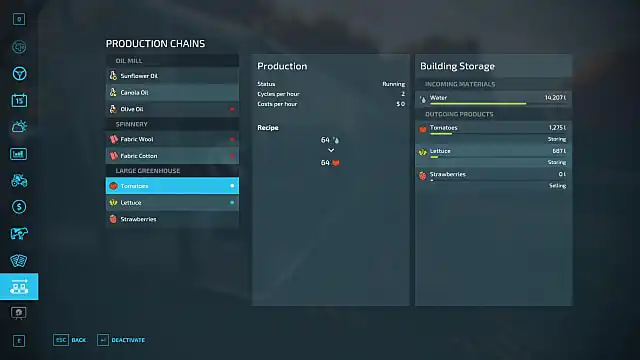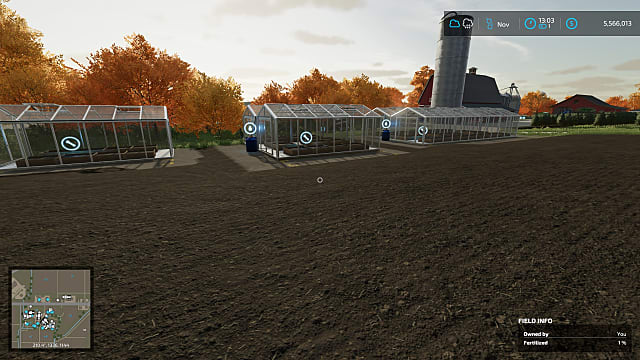Farming Simulator 22 greenhouses are worth their weight in gold. With a number of new crops and features added to FS 22, plant nurseries join solar panels and wind turbines as ways to make passive and active year-round money.
While they aren’t powerhouses of cash like chicken coops, greenhouses allow for consistent crop production with some good production chain potential. And all you have to do is add water! this guide goes over everything you need to know about these facilities in Farming Simulator 22.
Farming Simulator 22: Everything You Need to Know About Greenhouses
One Greenhouse Size to Rule Them All

If this is your first time playing Farming Simulator 22, you can access greenhouses, as well as a number of other buildable production facilities, from the triple horizontal bar icon at the bottom of the store tab and then selecting the construction menu. From there, select the production tab, and you’ll find the submenu for greenhouses.
Greenhouses come in three sizes:
- Small — $3,000
- Medium — $5,000
- Large — $10,000
Though all three sizes can grow the same crops — lettuce, tomato, and strawberries — the best bang-for-your-buck is the large greenhouse.
The large greenhouse requires the least amount of maintenance, and it has the largest water reservoir: 20,000L; the medium greenhouse and small greenhouse have reservoirs of 15,000L and 5,000L respectively.
You can expand your water storage further by buying supplementary water tanks under the silo extensions tab in the construction menu, but it only adds an additional 5,000L of capacity, so starting large mitigates this long-term investment.
Greenhouse Crop Grow Times and Ratios
Greenhouses grow crops year-round, which makes them a great way to keep earning money during the winter months if you’re playing Farming Simulator 22 with the seasonal crops option turned on. You can grow all three types of crops at once in the same greenhouse, but each crop has a different water-to-output ratio:
- Lettuce is 2:1
- Tomatoes are 1:1
- Strawberries are 1:2
Additionally, growing multiple crops in the same greenhouse actually lowers the amount produced per cycle of operation.
Lastly, pallets for lettuce, tomatoes, and strawberries are light enough that they can be loaded without a forklift or other type of loader.
Currently, lettuce, tomatoes, and strawberries can be sold at the fast-food restaurant, bowling alley restaurant, grocery store, and farmers’ market. Strawberries can additionally be sold at the bakery as well unless you own it, in which case they will be stored for use in the production of cakes instead.
Buy Multiple Greenhouses for More Efficient Production

Greenhouse maths for efficient production break down like this, highlighting why it’s best to buy additional greenhouses in order to keep crop cycle efficiency as high as possible :
Let’s say we have a large greenhouse, and we’re growing just tomatoes. Tomatoes are a 1:1 ratio and in a large greenhouse, that means two cycles of growth happen every hour. 64L of water turn into 64L of tomatoes every 30 minutes for a total of 128L water used and 128L of tomatoes produced per hour.
Now, we decide we also want to grow lettuce because prices are on the rise at the farmers’ market selling point. Since we’re now growing two crops in the same large greenhouse, we actually divide the cycles by two. In this setup, we’ll produce 64L of tomatoes from 64L of water and 32L of lettuce from 64L of water in an hour.
Some time goes by and we decide to get into the cake production line, meaning we’re going to need some strawberries. So we go to the greenhouse and add strawberries alongside the lettuce and tomatoes. Now, each cycle is divided by three meaning that per hour we’re getting ~43L of tomatoes, 21L of lettuce, and 85L of strawberries per hour.
Auto-Sell is Bad for Your Wallet: Don’t Do It
If your goal is making the maximum amount of money from your products, do not set your production facilities to auto-sell your goods.
Right now, close to Farming Simulator 22‘s launch, you lose 40% of sales to convenience fees if production facilities automatically sell your goods. Though manually selling goods can feel a bit micromanage-y, there are some ways to work around it through the use of the A.I. helpers if you’re playing solo.
That about sums up the basics of greenhouses in Farming Simulator 22. Nurseries are a great way to get into production, produce additional year-round income for your farm, and are an excuse to buy some of the cool transport additions to the game. For more tips, make sure to check out the rest of our Farming Simulator 22 guides here on GameSkinny!







Published: Dec 6, 2021 10:48 am